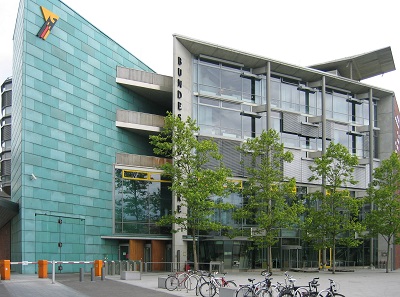February 2, 2017 – In 1989, Germany was re-united, which meant a major increase in work for the German Federal Printing Office, or Bundesdruckerei. Besides its capacity to print banknotes, this high-security printing company, originally founded as the Imperial Printing Company in 1879, had at its disposal lucrative monopoly contracts with the German government in the areas of identity document printing, stamps, visa and passport printing.
In order to compensate for the momentary increase of work due to reunification, the workforce was enlarged to 4,500 employees. After the initial workload of newly issued passports and identification documents declined, these overcapacities transformed into a heavy financial burden which the Kohl administration was keen to get rid of. For this reason, the Federal Cabinet approved to transform the state-owned company into a Gesellschaft mit beschränkter Haftung (Private Limited Company) in 1994. For the modernisation of the company, 270 million euros of government money was invested.
Central building of the German Federal Printing Office in Berlin 2005. Photo: Johann H. Addicks / GFDL 1.2
It was the major goal of Finance Minister Hans Eichel to operate in the black by 2004 at the latest – a ‘difficult aim’ to achieve in respect of all the liabilities caused by the reunification. One of the tools he used to accomplish this goal was the sale of the German Federal Printing Office in 2000 for 1 billion euros to the British private equity firm Apax. The firm only paid a quarter of the purchase amount out of its own pocket. Another quarter it still owed the Federal Ministry of Finance, and the remaining 500 million euros was loaned by the Hessische Landesbank, which is an institution of public law owned, among others, by the Federal State of Hesse, the Free State of Thuringia, and the Savings Banks and Giro Association Hesse-Thuringia.
Apax’ goal was to restructure and redevelop the slightly dusty state-owned company and to float it as an efficient company on the market. The goal was a 30% profit margin per year. For this reason Apax transferred its shares and liabilities to an independent company: Authentos GmbH. To this company, the Federal Printing Office was supposed to pay between 50 and 75 million euros per year in order to satisfy interest rates and pay off debts. By doing so, the payment of any taxes was avoided, because due to this specification the Federal Printing Office was certainly not able to make any profit.
However, profits remained far behind Apax’ expectations. The exact point of Authentos’ insolvency can hardly be determined, because the Hessische Landesbank and the German Federal Ministry of Finance waived all interest and other loan payments in order to at least preserve assets.
In 2002, a trust company bought Authentos for the symbolic purchase price of 1 euro. It was commissioned to find a buyer. However, due to 9/11, the security consciousness of the German government was heightened. It was decided that Authentos GmbH was not be sold to a foreign investor again – even though one is said to have outbid the 400 million euros offered by domestic bidder Giesecke & Devrient by more than double that amount.
Through an ultimatum, the trust company forced the government to make a final decision in 2008. The Federal Government decided to reassume possession of 100% of the Federal Printing Office.
As to the real cost to the German taxpayers, strict silence was maintained. Government circles let it be known that there was no cost to the government, as it was possible to offset the price against the debts which Authentos GmbH owed to the state.
This is surprising, because it can hardly be assumed that the Hessische Landesbank completely waived a reimbursement of its assets from the original purchase.
This article was first published in Mint News Quarterly 03 / 2016. Mint News Quarterly is issued by Currency News in association with Monea. Editor is Ursula Kampmann.





